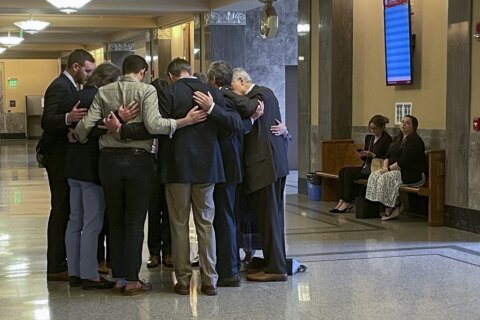CHARLOTTE, N.C. (AP) — Former Florida A&M University president Frederick S. Humphries, whose 16 years of leadership at the school are often referred to as its “golden years,” has died, a statement from the university said.
During his tenure, Humphries, who died Thursday at age 85, oversaw the revival of FAMU’s law school and doubled the university’s enrollment through scholarship programs that attracted highly talented students. A champion of historically Black colleges and universities and education for students of color, especially in the sciences, he led FAMU to be the leading producer of Black baccalaureate degree holders.
“Dr. Humphries is one of FAMU’s favorite sons. He committed his life to the advancement of higher education, in particular within the HBCU community, and changed the trajectory of FAMU,” current president Larry Robinson said in a statement. “We join the Humphries family, friends and Rattlers around the world in celebrating a life dedicated to service and one well lived.”
Born in Apalachicola, Florida, in 1935, Humphries graduated from FAMU in 1957 with a degree in chemistry. He later completed his masters and doctorate degrees in chemistry at the University of Pittsburgh, becoming the first Black person to obtain a Ph.D. from that program.
He taught at the University of Minnesota before returning to his alma mater as a professor of chemistry in 1968. In 1974, he was named the president of Tennessee State University, where he navigated the school’s merger and acquisition of the predominantly white University of Tennessee-Nashville campus.
In 1985, he became president of FAMU and established the Life Gets Better and Graduate School Feeder Program scholarships. He also drew increasing numbers of National Achievement Scholars to the school, ranking first in the country three times and outpacing Ivy League schools.
Reginald Mitchell, now Director of Academic Success and Bar Preparation Program at the FAMU College of Law, said Humphries was a generous and attentive mentor intent on creating opportunities for his students.
After completing his undergraduate degree in 1988, Mitchell told Humphries he thought FAMU could benefit from establishing a pre-law program, similar to other professional development tracks. Humphries agreed and directed Mitchell to pitch the idea around the university and make the program happen.
Establishing and running that program became Mitchell’s first job and eventually FAMU became one of the top feeder programs that sent Black students to law school. Mitchell said that despite how young he was at the time, Humphries made him feel capable of taking on big challenges.
“Working with him, I just felt undaunted,” Mitchell said. “Everybody would tell me how lucky I am and to be careful and it’s a big responsibility… He taught me to be fearless.”
FAMU lost its law school in 1965, after the state legislature voted to close the school and transfer the funds to the neighboring, predominantly white, Florida State University. Humphries fought for the reestablishment of the law school, which the state legislature and governor approved in a 2000 bill. The school is now located in Orlando.
In all areas, from fundraising to student recruitment, alumni said Humphries was driven to prove FAMU could match and even outpace the country’s most elite institutions.
Greg Clark, president of the FAMU National Alumni Association, said one of Humphries’ greatest points of pride was when the school was named “College of the Year” by Time Magazine.
At 6-foot-7, with a boisterous voice and a towering presence, Humphries commanded every room he walked in but remained a “jokester,” Clark said. At football games, Humphries was known for stirring up the crowd as he led the “Rattler Charge,” Clark said.
Humphries never lost touch with his Apalachicola roots. Recently, he told Clark that if something were to happen to him, he wanted his loved ones to celebrate by eating Apalachicola oysters and fish.
“He was that kind of jokester,” Clark said. “I’m sure as we started to plan out his celebration that we’ll probably try to get our hands on some Apalachicola oysters.”
Humphries left FAMU in 2001 and became president and CEO of the National Association for Equal Opportunity in Higher Education. In addition, he was later named a Regent Professor at the law school and served on numerous corporate boards.
But even decades removed from his presidency at FAMU, the school was still on his mind. As recently as the week before his death, Humphries was still imagining ways to advance FAMU’s work. He told Mitchell he thought the school should consider expanding its signature scholarships to the law school. Mitchell said he immediately began taking mental notes, once again getting guidance from his long-time mentor.
“The wheels were still churning, and he was still talking about ways to raise funds and to raise the image and to raise the success of the university,” Mitchell said.
Humphries is survived by his three children, Frederick Jr., Robin Tanya Watson and Laurence Humphries, as well as eight grandchildren. His wife, Antoinette McTurner Humphries, died in 2006.
Funeral arrangements have not been finalized, the university said in a statement.
___
Ma covers education and equity for AP’s Race and Ethnicity team. Follow her on Twitter: https://www.twitter.com/anniema15
___
The Associated Press’ reporting around issues of race and ethnicity is supported in part by the Howard Hughes Medical Institute’s Department of Science Education. The AP is solely responsible for all content.
Copyright © 2024 The Associated Press. All rights reserved. This material may not be published, broadcast, written or redistributed.







